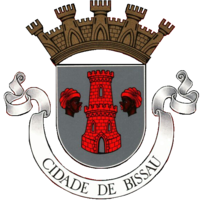Bissau
This article is about the capital of Guinea-Bissau. For a town in Rajasthan, India: Bissau, Rajasthan
Bissau | |
|---|---|
 | |
| Country | |
| Region | Bissau Region |
| Area | |
| • Total | 77 km2 (30 sq mi) |
| Population (2007) | |
| • Total | 407,424 est. |
Bissau is the capital city of Guinea-Bissau. It is an autonomous city whose borders are conterminous with the Bissau Region. As of 2007, the city has an estimated population of 407,424 according to the Instituto Nacional de Estatística e Censos [1]. The last time an official census was held in the country, in 1991, the city/region had a population of 195,389. The city is located on the Geba River estuary, off the Atlantic Ocean. It is the country's largest city, major port, and administrative and military center. Peanuts, hardwoods, copra, palm oil, and rubber are the chief products. The city was founded in 1687 by Portugal as a fortified port and trading center. In 1942 it became the capital of Portuguese Guinea. After the declaration of independence by the guerilla, in 1973, the capital of the independent territory was declared to be Madina do Boe, but Bissau remained as the capital of the Portuguese-occupied regions, i. e., of Portuguese Guinea. When Portugal recognized the independence of Guinea-Bissau and pulled out, in 1974, the two territories merged and Bissau became the capital of the new state. Bissau is located at 11°52' North, 15°36' West (11.86667, -15.60). [1]


The city is known for its annual carnival. Other attractions include the Fortaleza d'Amura barracks containing Amílcar Cabral's mausoleum, the Pidjiguiti Memorial to the dockers killed in the Bissau Dockers' Strike on August 3 1959, the Guinea-Bissau National Arts Institute, Bissau New Stadium and local beaches. Many buildings in the city were ruined during the Guinea-Bissau Civil War, including the Guinea-Bissau Presidential Palace and the Bissau French Cultural Centre (now rebuilt), and the city centre is still underdeveloped.

The airport that serves Bissau is Osvaldo Vieira International Airport.
External links
References
- Richard Andrew Lobban, Jr. and Peter Karibe Mendy, Historical Dictionary of the Republic of Guinea-Bissau, 3rd ed. (Scarecrow Press, 1997, ISBN 0-8108-3226-7) pp. 91-96

